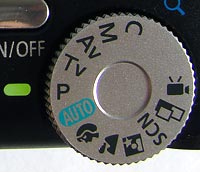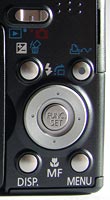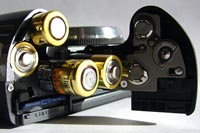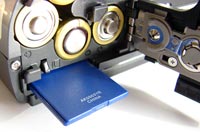Canon Powershot A640 Review
Date: November 27th 2006
Author: Gavin Stoker
Leave a Comment about this Review
|
Ease of Use
In the past Canon's A-series PowerShots were the drab budget range, offering an entry point for novice users at the cheapest end, and rather more robust, traditional looking � but still boring � compacts for those looking to upgrade relatively inexpensively at the other. Happily the new Canon PowerShot A640 looks like a more solid proposition in every sense of the word, plus its 10 megapixel resolution places it at the head of the family in terms of specification.
While its chunkier frame and handgrip housing four standard AA batteries may not make it a match for the sleek lines of a Canon IXUS, that added weight, plus its black body shell, reassures by disguising the mainly plastic build. Nothing here feels cheap however, and, as we'd expect from Canon, build quality is high with buttons and controls feeling firm to the touch. A flip and twist 2.5-inch LCD dominates the rear, allowing for a variety of viewing angles and creative compositions (including most usefully shooting over the heads of crowds), with a small, largely superfluous optical viewfinder above. Keeping matters relatively streamlined and maintaining an air of sophistication, the LCD can be safely stored screen-side into the body when not in use.
To the front of the Canon PowerShot A640, a removable ring encircles the recessed 4x zoom lens barrel, below which is a ring release button so that you have the option of attaching optional wide (0.7x) or tele (1.75x) converter lenses. As with Canon's other compacts, a zoom lever encircles the shutter button, situated forward of the grip so that both are controlled via the forefinger. Personally I prefer the zoom control to fall under the thumb on the camera back, but here instead you get a switch for swapping between playback and capture, as that facility isn't included on the familiar mode wheel which sits directly above, slightly recessed into the top of the camera. To the left of this (if viewed from the rear) is a slightly recessed lozenge-shaped on/off button.
The mode wheel too has a nice firm action, so you're not likely to slip from one setting to the other when hurriedly switching to catch that once-in-a-lifetime photo opportunity. Ranged around the wheel are the usual collection of shooting options which kick off with full auto, and move clockwise through the self-described 'creative zone' of Program, Tv (shutter speed priority), Av (aperture priority) and Manual modes, and then onto video capture, stitch assist setting for shooting panoramas, 10 scene modes (including underwater and colour swap options), then night scene, landscape, portrait, and back to auto again.
| Mode Dial | Main Controls |
 |
 |
Returning to the camera back you have the ubiquitous four-way controller situated bottom right of the LCD screen, for tabbing through onscreen menus and effecting changes via its central 'Function set' button. Ranged above this are a dual function button for adjusting exposure or deleting images, and, this being a Canon, a print/share button via use of which hard copies can be output via a PictBridge enabled standalone printer (such as its Pixma or Selphy ranges).
Nestling below the control dial are two further buttons, one marked 'disp' for calling up the on-screen display or switching on/off the LCD monitor and the other the self-explanatory menu button. In capture mode pressing the top edge of the control pad selects the various flash settings, while a press of the bottom edge calls up the macro or manual focus options. Zoom lever aside, everything feels in its rightful place, making not only for an uncluttered layout but also one that allows quick and easy access to boot. If I've one grumble it's that the batteries and card slot share the same compartment at the camera base, meaning that you have to cup a hand around the batteries, or turn the camera upside, to retrieve your card without the AA cells also spilling out.
Thanks in part to its on-board Digic II processor, shared with Canon's DSLRs, the Canon PowerShot A640 powers up in just over a second, the review screen blinking into life and the 4x zoom veritably leaping to maximum wide angle setting with an audible whirr. Key settings automatically displayed on screen include the drive mode (single shot, continuous or two or 10 second self timer), metering mode (evaluative, centre weighted average, or spot), JPEG compression level (Super Fine, Fine or Normal) plus file size (from Large at 3648x2736 pixels down to Small at 640x480, plus 'postcard' at 1600x1200 and widescreen at 3648x2048) and finally the number of shots remaining. There's no live histogram however, a somewhat obvious omission, though exposure is evenly handled. Images are saved onto SD card, for which a 32MB variety was supplied with our review sample. Unsurprisingly, you'll want to budget for a larger card.
The camera locks on target more or less instantly, with an AF assist light coming in useful in low light situations when the subject was within a couple of feet. Further than that and (without flash) the camera struggled, with the lens hunting around. In shutter priority and aperture priority modes, you get shutter speed or aperture size respectively added to the on screen display, while manual mode also displays the power setting for the flash (which can usefully be adjusted to suit conditions at the time for more flattering portraiture when you really do have to use flash).
Interestingly, though this is a compact arguably aimed more at enthusiast than beginner and currently sits atop the A-series range (with its 10MP resolution), Canon hasn't included any form of image stabilisation, optical or mechanical (CCD shift) on the PowerShot A640. As similarly priced and pitched models do offer this, it feels like an oversight, though doubtless Canon would direct customers to one of its higher-end IXUS's instead. More positively, whether used as a viewfinder indoors or out, the A640's 2.5-inch screen is bright and clear and is free from the likes of ghosting or noise. And, as we've found with Canons in the past, there's no faulting the A640's on-screen menu layout or navigation, which are logically ordered and unfussy with readily familiar icons in any instance where there isn't explanatory text.
| Battery Compartment | Memory Card Slot |
 |
 |
Pressing the menu button in any shooting mode calls up a trio of folders on screen that you use the four-way pad to tab between. In camera mode you get to effect rudimentary changes like turning the digital zoom or AF assist beam on/off � and in the likes of Program mode adjust the AF setting (from the usual 9-point AiAF through Centre or FlexiZone AF settings) or implement slow sync flash. In set up mode, denoted by wrench and hammer, the usual suspects are joined by the essentials of being able to format the card and select PAL or NTSC video plus 'reset all' the settings if someone else has been fiddling with the unit (more of an issue for us reviewers than Canon's customers). The third menu folder is rather less essential and controls operational images and sounds; it has to be said that I never bother with this one. Press the function button at the centre of the camera's control pad and rather more excitingly you get to access the key shooting spec, ranged in an L-shape along the left hand side and bottom of the screen. This again is a common Canon layout trait, saving you tabbing through busy menu screens to get to the essentials.
In auto capture mode, highlighted options are limited to auto or 'Hi' ISO, the aforementioned drive mode, compression level and image size. A twist of the dial to Program mode highlights all the other options, with light sensitivity from ISO80 to IS0800 (arguably the highest you'd want anyway given the results, more on which later), white balance (which includes an underwater setting and purist-pleasing custom setting), plus the Canon 'My colours' palette, with adjustment from vivid, through neutral (cool), sepia, black and white, positive film, lighter or darker skin tones, vivid blue, red, green (which make little discernable difference) and, again, a custom colour setting, allowing you to prioritize a particular shade in an image. You also get to adjust flash strength via a slider bar. So far, so intuitive, while the A640 is again quick to respond to changes.
Switching the slider on the camera back to playback mode brings up four possible menu folders, including the set up and image/sound ones as before, foreshadowed by playback and print options. The playback list includes a slideshow option, with the time saving ability to jump 10 images at a time if scrolling through a particularly large collection (or jump to particular image folders or movie clips), rotate images, add sound memos or protect them from accidental deletion. The Print menu allows you to select individual (or all) images and number of copies required in-camera, or print with date and or file number on or off depending on your intentions for cataloguing.
Overall operation impresses � the Canon PowerShot A640 is easy to use, swift and responsive, whether switching between settings, determining critical focus or playing back images � and battery life is more than acceptable (good for up to 280 shots with the AAs supplied, or a claimed 500 with Canon's optional NB-2AH variety), for all its lack of supplied rechargeables. Not too much more you could ask for then, although some form of image stabilisation would be pretty high up the 'wish list' for its next generation.
|
![]() PhotographyBLOG
is a member of the DIWA
organisation. Our test results for the Canon Powershot A640
have been submitted to DIWA
for comparison with test results for different samples of
the same camera model supplied by other DIWA
member sites.
PhotographyBLOG
is a member of the DIWA
organisation. Our test results for the Canon Powershot A640
have been submitted to DIWA
for comparison with test results for different samples of
the same camera model supplied by other DIWA
member sites.
